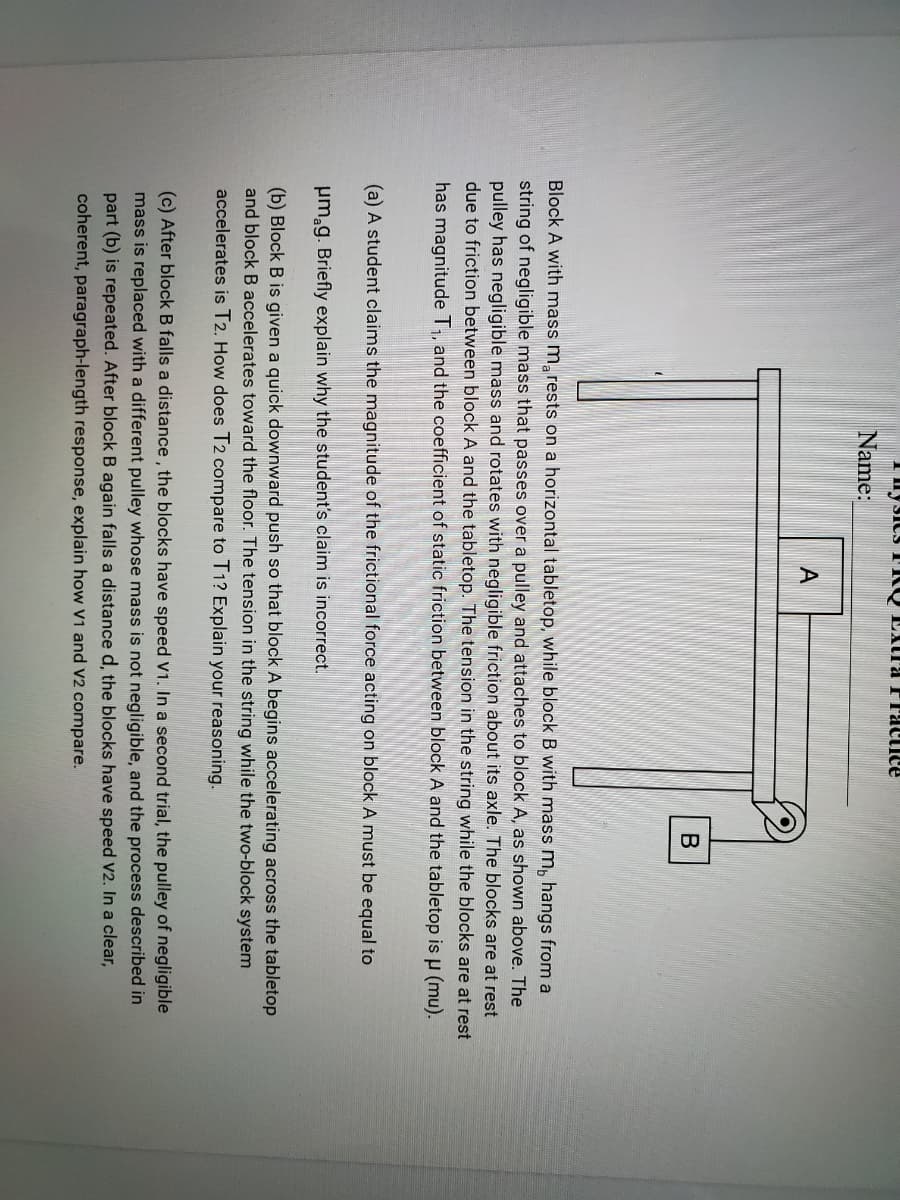A В Block A with mass m, rests on a horizontal tabletop, while block B with mass m, hangs from a string of negligible mass that passes over a pulley and attaches to block A, as shown above. The pulley has negligible mass and rotates with negligible friction about its axle. The blocks are at rest due to friction between block A and the tabletop. The tension in the string while the blocks are at rest has magnitude T1, and the coefficient of static friction between block A and the tabletop is u (mu). (a) A student claims the magnitude of the frictional force acting on block A must be equal to pmg. Briefly explain why the student's claim is incorrect. (b) Block B is given a quick downward push so that block A begins accelerating across the tabletop and block B accelerates toward the floor. The tension in the string while the two-block system accelerates is T2. How does T2 compare to T1? Explain your reasoning. (c) After block B falls a distance, the blocks have speed V1. In a second trial, the pulley of negligible mass is replaced with a different pulley whose mass is not negligible, and the process described in part (b) is repeated. After block B again falls a distance d, the blocks have speed V2. In a clear, coherent, paragraph-length response, explain how V1 and V2 compare.
A В Block A with mass m, rests on a horizontal tabletop, while block B with mass m, hangs from a string of negligible mass that passes over a pulley and attaches to block A, as shown above. The pulley has negligible mass and rotates with negligible friction about its axle. The blocks are at rest due to friction between block A and the tabletop. The tension in the string while the blocks are at rest has magnitude T1, and the coefficient of static friction between block A and the tabletop is u (mu). (a) A student claims the magnitude of the frictional force acting on block A must be equal to pmg. Briefly explain why the student's claim is incorrect. (b) Block B is given a quick downward push so that block A begins accelerating across the tabletop and block B accelerates toward the floor. The tension in the string while the two-block system accelerates is T2. How does T2 compare to T1? Explain your reasoning. (c) After block B falls a distance, the blocks have speed V1. In a second trial, the pulley of negligible mass is replaced with a different pulley whose mass is not negligible, and the process described in part (b) is repeated. After block B again falls a distance d, the blocks have speed V2. In a clear, coherent, paragraph-length response, explain how V1 and V2 compare.
University Physics Volume 1
18th Edition
ISBN:9781938168277
Author:William Moebs, Samuel J. Ling, Jeff Sanny
Publisher:William Moebs, Samuel J. Ling, Jeff Sanny
Chapter12: Static Equilibrium And Elasticity
Section: Chapter Questions
Problem 37P: To get up on the roof, a person (mass 70.0 kg) places 6.00-m aluminum ladder (mass 10.0 kg) against...
Related questions
Question
this is for frq practice (not a grade) . It is a short free-responce question.

Transcribed Image Text:-y siCs T RQ EIIra Fractice
Name:
Block A with mass m, rests on a horizontal tabletop, while block B with mass m, hangs from a
string of negligible mass that passes over a pulley and attaches to block A, as shown above. The
pulley has negligible mass and rotates with negligible friction about its axle. The blocks are at rest
due to friction between block A and the tabletop. The tension in the string while the blocks are at rest
has magnitude T, and the coefficient of static friction between block A and the tabletop is u (mu).
(a) A student claims the magnitude of the frictional force acting on block A must be equal to
um g. Briefly explain why the student's claim is incorrect.
(b) Block B is given a quick downward push so that block A begins accelerating across the tabletop
and block B accelerates toward the floor. The tension in the string while the two-block system
accelerates is T2. How does T2 compare to T1? Explain your reasoning.
(c) After block B falls a distance , the blocks have speed v1. In a second trial, the pulley of negligible
mass is replaced with a different pulley whose mass is not negligible, and the process described in
part (b) is repeated. After block B again falls a distance d, the blocks have speed V2. In a clear,
coherent, paragraph-length response, explain how V1 and V2 compare.
Expert Solution
This question has been solved!
Explore an expertly crafted, step-by-step solution for a thorough understanding of key concepts.
This is a popular solution!
Trending now
This is a popular solution!
Step by step
Solved in 4 steps with 2 images

Knowledge Booster
Learn more about
Need a deep-dive on the concept behind this application? Look no further. Learn more about this topic, physics and related others by exploring similar questions and additional content below.Recommended textbooks for you

University Physics Volume 1
Physics
ISBN:
9781938168277
Author:
William Moebs, Samuel J. Ling, Jeff Sanny
Publisher:
OpenStax - Rice University

University Physics Volume 1
Physics
ISBN:
9781938168277
Author:
William Moebs, Samuel J. Ling, Jeff Sanny
Publisher:
OpenStax - Rice University